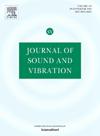Moving homogenization model for elastic wave propagation in a porous composite with gradient porosity
IF 4.3
2区 工程技术
Q1 ACOUSTICS
引用次数: 0
Abstract
The elastic wave propagation in gradient porous composite depends highly on the porosity gradient. There are limited theoretical studies to understand the wave propagation behavior in such composite mainly due to the lack of efficient and accurate modeling tools. To address this issue, a moving homogenization model is developed to characterize wave propagation behavior in gradient porous composites when the multiple wave scattering caused by cavities with gradient porosity is considered. The gradient porous composite is approximated by a series of segments with piecewise uniform porosities in order to meet the condition to employ the multiple scattering model developed by Waterman and Truell [P.C. Waterman, R. Truell, Multiple scattering of waves, Journal of Mathematical Physics 2 (1961) 512-537] in each segment. The moving average technique is applied to consider the multiple scattering effects from cavities in other segments. The moving homogenization model based on modified double moving average is formulated to obtain the equivalent complex wavenumber for each segment to allow the prediction of the wave propagation through these segments. The proposed model is verified numerically by meso-scale finite element simulations of the anti-plane shear horizonal (SH) wave propagation in a gradient porous composite. The validity conditions of the proposed model are determined analytically and numerically. Finally, a parametric analysis is conducted to reveal the gradient variation effects on wave propagation behavior.
求助全文
约1分钟内获得全文
求助全文
来源期刊

Journal of Sound and Vibration
工程技术-工程:机械
CiteScore
9.10
自引率
10.60%
发文量
551
审稿时长
69 days
期刊介绍:
The Journal of Sound and Vibration (JSV) is an independent journal devoted to the prompt publication of original papers, both theoretical and experimental, that provide new information on any aspect of sound or vibration. There is an emphasis on fundamental work that has potential for practical application.
JSV was founded and operates on the premise that the subject of sound and vibration requires a journal that publishes papers of a high technical standard across the various subdisciplines, thus facilitating awareness of techniques and discoveries in one area that may be applicable in others.
 求助内容:
求助内容: 应助结果提醒方式:
应助结果提醒方式:


